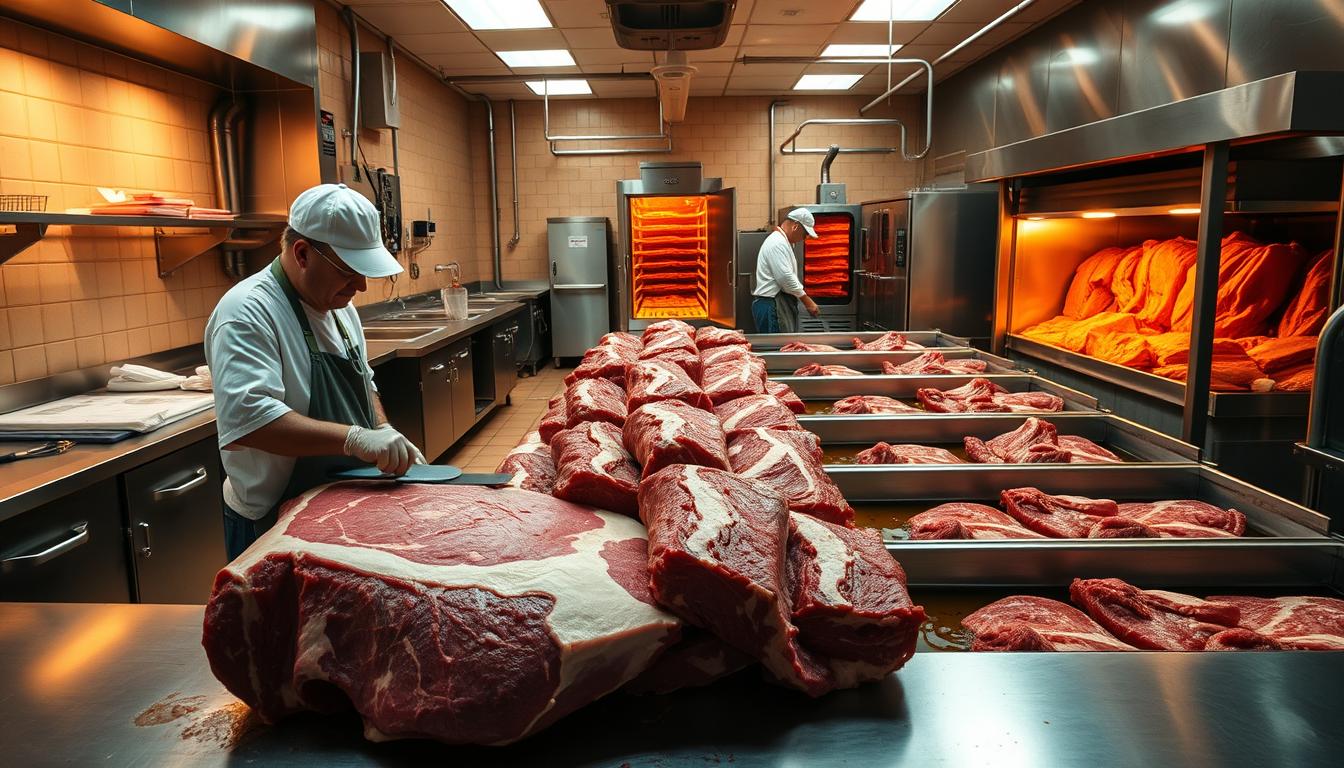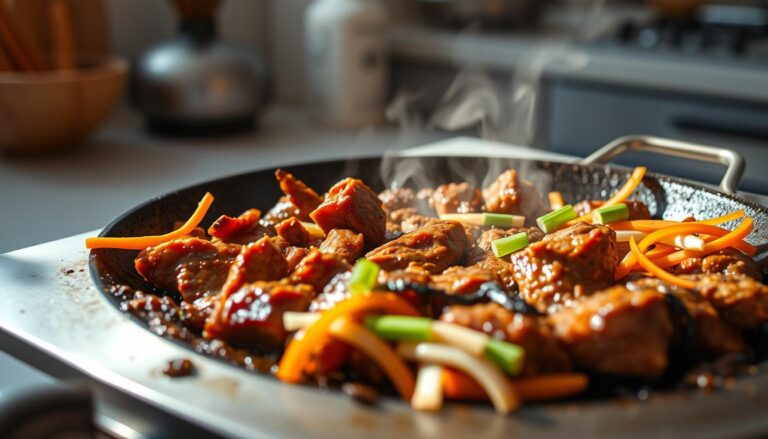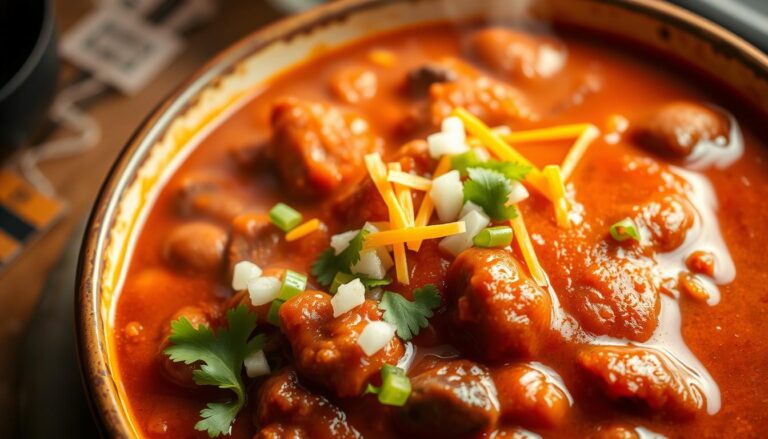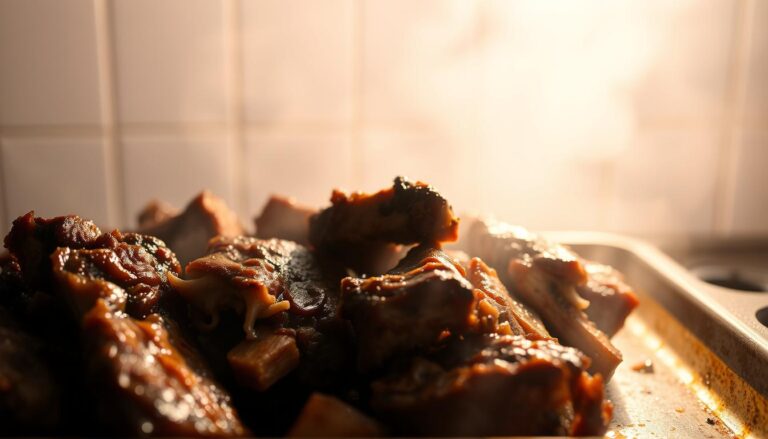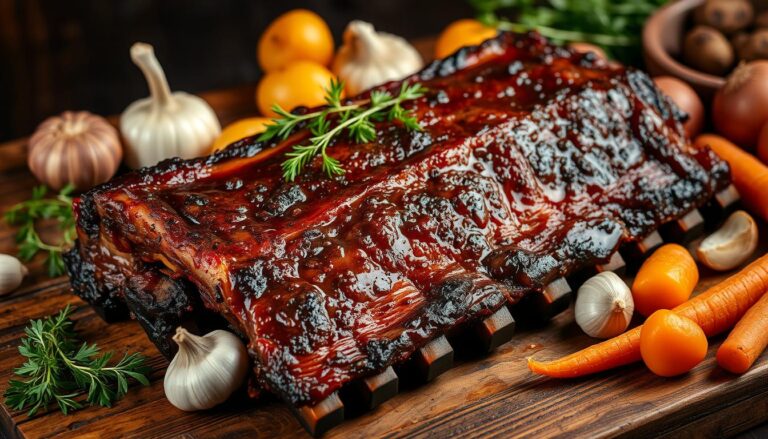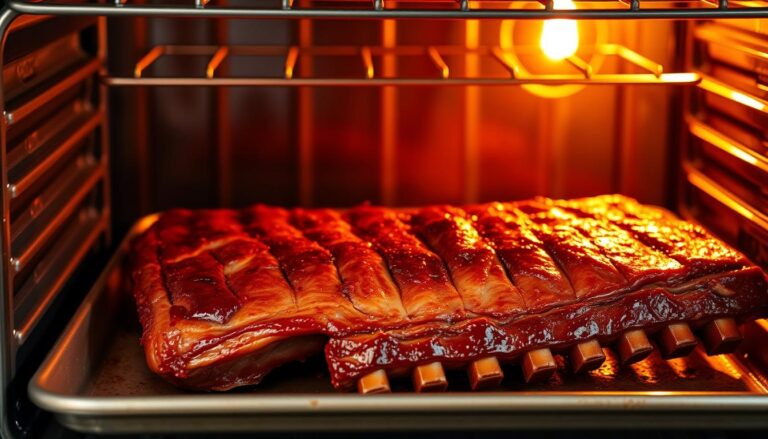Ever wondered how corned beef is made? This guide takes you through every step, from picking the right meat to slow-cooking it. You’ll learn the science and tradition behind making this tender, flavorful dish loved by all.
Learning about corned beef starts with its main steps: brining, cooking, and finishing. Each step is crucial for its unique taste and texture. This guide makes it easy to try it at home.
Discover the secrets of brine mixtures, timing, and techniques. Whether for a family dinner or a holiday feast, knowing how to make corned beef ensures a perfect, savory dish every time.
Table of Contents
Introduction to Corned Beef
Ever wondered how a simple slab of meat becomes a holiday favorite? Corned beef is more than a dish—it’s a blend of tradition and science. Its journey from raw beef to your plate starts with the corned beef preparation process, a method steeped in history and flavor.
What is Corned Beef?
At its core, corned beef is cured beef brisket soaked in a brine of salt, peppercorns, and spices. The term “corned” refers to the large salt crystals used, not the meat’s texture. This curing process preserves the meat while infusing it with savory depth. The corned beef preparation process ensures it stays tender even after long cooking times.
Why It’s a Beloved Tradition
- Rich Heritage: Rooted in Irish-American traditions, it’s a St. Patrick’s Day staple in many households.
- Flavor Versatility: Whether simmered in stews or served with cabbage, its smoky-salty taste adapts to any meal.
- Family Legacy: Recipes often pass through generations, making it a symbol of shared memories.
Learning the corned beef preparation process unlocks more than cooking—it connects you to stories of survival, migration, and celebration. Every step, from brining to boiling, carries centuries of history into your kitchen.
The History of Corned Beef
Centuries ago, keeping meat fresh was crucial for survival. Sailors and farmers used salt to make beef last on long trips. These early methods are the base for today’s steps to make corned beef.
| Time Period | Key Development |
|---|---|
| 17th Century | Irish dry-curing methods |
| 1860s | Wet brine recipes emerge |
| 20th Century | Commercial production scales up |
Today, steps to make corned beef still use salt’s preserving power. Early methods were about survival, while now it’s about taste and quality.
“Salt was their spice rack.”
Looking into this history shows how tradition influences our cooking. Every step to make corned beef links to centuries of creativity and need.
Key Ingredients and Their Roles
Learning to cook corned beef at home begins with knowing its main parts. Each ingredient is crucial in making the meat tender and tasty. Let’s explore what you need to know before starting.
Selecting the Right Cut
Brisket is the key to cooking corned beef at home. Look for a cut with lots of fat. This fat keeps the meat juicy during cooking. Stay away from lean cuts, as they can dry out.
Choose a 3–5 pound packer brisket. It’s the top pick for home cooks.
Understanding the Brine
A good brine is essential for curing and flavoring the meat. It includes:
- Salt: It draws moisture and seasons the meat well.
- Curing Salt: This has sodium nitrite for safety and that pink color. Brands like Morton® TenderQuick are key.
- Spices: Peppercorns, bay leaves, and garlic add flavor. Adjust to taste but keep salt levels right.
Too much salt can spoil the dish. Stick to the right ratios—1 cup pickling salt, 1/2 cup curing salt, and spices per gallon of water.
Brining: The First Step in Corned Beef Preparation
Brining is key to making your homemade corned beef tender and tasty. It uses salt and spices to cure the meat. This process breaks down fibers and adds flavor.
Preparing the Brine
Start by mixing salt, sugar, and spices in water. Important ingredients include:
- Pickling salt (no additives) for curing
- Peppercorns, bay leaves, and mustard seeds for depth
- Optional: brown sugar to balance saltiness
Marinating Time Considerations
Marinating time depends on the meat’s thickness and cut. Too long can make it too salty. Too short might not flavor it evenly. Here’s a guide:
| Meat Cut | Marinating Time | Notes |
|---|---|---|
| Brisket | 5-7 days | Refrigerate at 35–40°F (2–4°C) |
| Round | 3-5 days | Less dense cuts absorb brine faster |
| Chuck | 7-10 days | Thicker cuts require extended curing |
Check the meat weekly, flipping it to ensure even coverage. Proper brining is crucial for the slow cooking stages that follow.
How is Corned Beef Made: The Process Explained
Making corned beef is all about precision. Follow these steps to transform raw meat into a delicious dish. Remember, safety comes first.
Step-by-Step Process
- Trim excess fat from your brisket or rump roast, ensuring even brine absorption.
- Submerge the meat in the prepped brine solution, ensuring full coverage for 1-2 weeks in the refrigerator.
- After brining, rinse the meat thoroughly under cold water to remove excess salt.
- Pat dry with paper towels and optionally refrigerate overnight to enhance texture.
- Store properly until ready for cooking, following USDA guidelines for cold storage.
Safety and Hygiene Tips
| Safety Tip | Description |
|---|---|
| Temperature control | Keep brine submerged and refrigerated at ≤40°F (4°C) to prevent bacterial growth. |
| Clean equipment | Use sterilized containers and utensils to avoid contamination. |
| Proper disposal | Discard unused brine immediately after use to prevent spoilage risks. |
By following these tips, your homemade corned beef will be safe and tasty. Each step is crucial for a perfect dish.
Slow Cooking and Finishing Touches
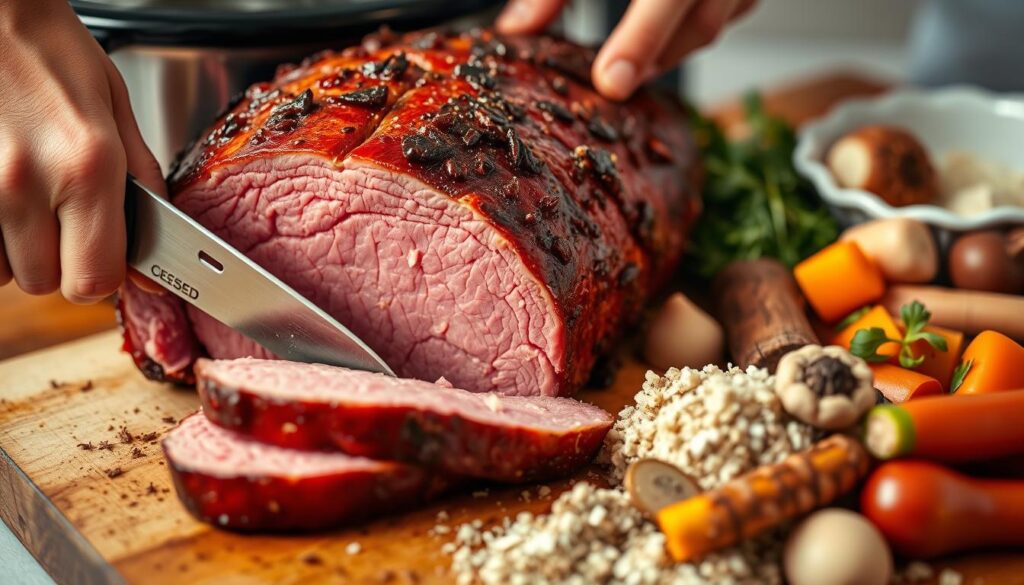
At this point in the corned beef preparation process, slow cooking makes the meat tender. Use a Dutch oven or slow cooker for steady heat. Keep the temperature between 275°F and 300°F. This low heat breaks down tough tissues.
| Method | Time | Temperature | Best For |
|---|---|---|---|
| Slow Cooker | 6-8 hours (low) | N/A | Hands-off convenience |
| Stovetop | 3-4 hours | Simmer, not boil | Direct temperature control |
| Oven | 3-4 hours | 275°F | Even heat distribution |
After cooking, let the meat rest for 10-15 minutes. This helps keep the juices inside. Slice it against the grain for tenderness. Serve with classic sides like cabbage, potatoes, or mustard. For more flavor, baste with pan juices in the last hour.
Pro tip: Check if the meat is done by inserting a fork. If it slides in easily, it’s ready. Don’t overcook it to avoid dryness. The corned beef preparation process ends with presentation—add fresh herbs like parsley for a pop of color.
- Rest the meat before slicing.
- Use a sharp knife for even slices.
- Serve warm, not hot, for best texture.
By following these steps, you’ll have corned beef that looks great and tastes amazing. The right finishing touches make a good meal unforgettable.
Corned Beef Preparation Process Tips and Tricks
Learning to make steps to make corned beef is more than just a recipe. It’s about improving your skills. These tips will help you make your dish stand out.
Flavor Enhancement Techniques
Here are some ways to add more flavor:
- Try adding fresh herbs like thyme or rosemary to the brine.
- Smoke the meat for a bit before cooking for a smoky taste.
- Put a bay leaf in during the last hour of cooking.
Storage and Reheating Advice
Keep your dish fresh for longer with these tips:
| Storage Method | Max Time | Notes |
|---|---|---|
| Refrigerator | Up to 1 week | Wrap tightly in foil |
| Freezer | 3 months | Use vacuum-sealed bags |
To reheat, place slices in a steps to make corned beef broth. Simmer for 5-7 minutes. Don’t use the microwave to keep it moist.
- Freeze leftovers in single portions
- Refrigerate uncovered slices once they’re cool
Cooking Corned Beef at Home: Tools and Techniques
To cook corned beef at home like a pro, you need the right tools. A heavy-duty pot, like a Lodge Dutch oven or a Crock-Pot slow cooker, helps with even heat. A meat thermometer is key to check the meat’s internal temperature—aim for 165°F to 175°F. You’ll also need tongs, a slotted spoon, and parchment paper for wrapping.
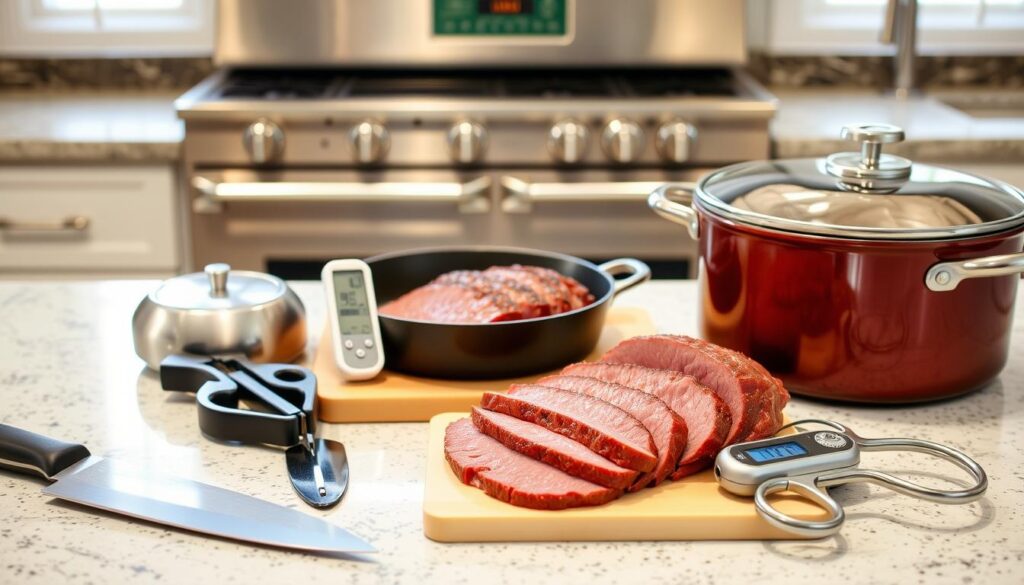
- Pot: Use a deep pot with a tight lid to keep moisture in.
- Slow cooker: Great for those with busy schedules, it cooks hands-off.
- Thermometer: It helps prevent overcooking by checking the meat’s temperature.
Simmer the meat in a pot on the stovetop, covered, for 2–3 hours. For slow cooking, layer corned beef with onions and spices, then cook on low for 6–8 hours. Let it rest 10 minutes before slicing against the grain for tenderness. A pro tip: Use broth from cooking for gravies or soups.
“The key to great corned beef is patience—low and slow wins every time.” – Chef Emily Torres, New York Deli Specialist
Try using an Instant Pot for quicker results, but use the 10-pound pressure setting. Always follow package guidelines for brine-soaked meat. With these tools and methods, you’ll get restaurant-quality results every time.
Homemade Corned Beef Recipe Variations
Try new twists on your homemade corned beef recipe. From classic to modern, these changes let you make it your own.
“The best recipes evolve while honoring their origins.” — Chef Maria Gonzalez, culinary historian
- Irish Style: Simmer with Guinness beer and thyme for a smoky depth.
- New York Jewish Deli: Add caraway seeds and allspice to the brine.
- Southwestern: Use chili powder and smoked paprika in the marinade.
Modern twists include:
- Low-sodium brine options for healthier diets.
- Herb-infused oils in the cooking liquid.
- Gluten-free brine mixes for dietary restrictions.
| Region | Signature Ingredient | Flavor Profile |
|---|---|---|
| Irish | Guinness | Smoky & earthy |
| Midwest | Maple syrup | Sweet-savory balance |
| Southern | Pepper flakes | Spicy and bold |
Try these ideas to make your corned beef recipe unique. Change brine ratios or cooking methods to fit your taste. Whether you’re keeping a family tradition or trying something new, there’s endless possibility.
Conclusion
Learning how corned beef is made is a mix of tradition and careful steps. It begins with picking the right cut of meat and making the brine. Each step is important, from using special spices to slow cooking.
Whether you stick to old recipes or try new ones, like beer-brined, safety and patience are crucial. Keeping leftovers safe and warm is key for enjoying them in sandwiches or stews. You can also add your own twist, from Irish recipes to American favorites.
Now, it’s time to make your own corned beef. Choose the right cut, mix the brine, and let it sit. The end result is a dish that’s both familiar and unique. Share it with loved ones, try different spices, or serve it with cabbage and carrots. Every step you take makes the final meal special.

